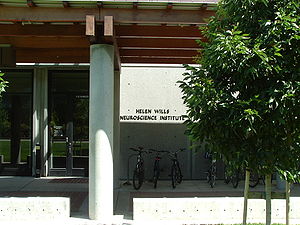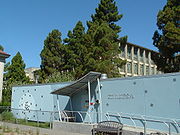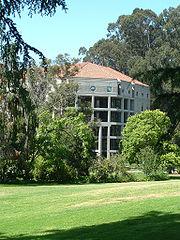
Helen Wills Neuroscience Institute
Encyclopedia
The Helen Wills Neuroscience Institute (HWNI) at the University of California, Berkeley
was founded in 1999 with assistance from a US$10 million bequeathal left by eight-time Wimbledon
champion Helen Wills Moody
, an alumna of the University of California - Berkeley.
 After the death of Helen Wills Moody in 1998 the University of California, Berkeley approved the foundation of a new neuroscience
After the death of Helen Wills Moody in 1998 the University of California, Berkeley approved the foundation of a new neuroscience
research institute. In order to honor the contributions to the university by this alumna her name was made eponymous with the institute. In 1999 the institute officially became a part of the University, forming its own graduate school
which offers a doctorate
in neuroscience. The first student to receive a PhD
in Neuroscience from the institute was Thomas Muench, PhD who graduated in 2005. At any time there are approximately 40 graduate students in the department, though there is no undergraduate neuroscience program.
The institute now encompasses over 40 research faculty from many departments including: Molecular
& Cellular Biology, Psychology
, Integrative Biology, Vision Science
, Chemical Engineering
, Electrical Engineering
& Computer Science
, Physics
, Environmental Science, Policy & Management
and Anthropology
. The institute supports 5 general subdivisions within neuroscience: Cellular
, Cognitive
, Developmental, Molecular
, and Systems.
and behavior
, and the potential for therapies and cures of neurological diseases. The mission
of the Helen Wills Neuroscience Institute include:
 The Henry H. "Sam" Wheeler, Jr. Brain Imaging Center (BIC) is led by Mark D'Esposito, MD. This facility houses one of the most powerful (and the most powerful at the time of its installation) human research functional Magnetic Resonance Imaging
The Henry H. "Sam" Wheeler, Jr. Brain Imaging Center (BIC) is led by Mark D'Esposito, MD. This facility houses one of the most powerful (and the most powerful at the time of its installation) human research functional Magnetic Resonance Imaging
(fMRI) system in the United States
. The 4 tesla
magnet
provides an opportunity for research collaboration in functional neuroimaging
among diverse fields. Data
are analyzed at the Judy & John Webb Neuroimaging Computational Facility also housed on the Berkeley campus.
 The Molecular Imaging Center is led by Ehud Isacoff, PhD. This facility aims to image--at the molecular level--the dynamic properties of in vitro
The Molecular Imaging Center is led by Ehud Isacoff, PhD. This facility aims to image--at the molecular level--the dynamic properties of in vitro
neurons by utilizing molecular optical reporters of neural function.
, California
. The RNI was established by Jeff Hawkins
in August, 2002. Many of the researchers from the RNI joined the University as faculty or staff, and the institute was renamed the Redwood Center for Theoretical Neuroscience. Through the use of various electro-
and magnetophysiological techniques, this group hopes to discover an underlying biological
mathematics model of memory
and cognition
.
University of California, Berkeley
The University of California, Berkeley , is a teaching and research university established in 1868 and located in Berkeley, California, USA...
was founded in 1999 with assistance from a US$10 million bequeathal left by eight-time Wimbledon
The Championships, Wimbledon
The Championships, Wimbledon, or simply Wimbledon , is the oldest tennis tournament in the world, considered by many to be the most prestigious. It has been held at the All England Club in Wimbledon, London since 1877. It is one of the four Grand Slam tennis tournaments, the other three Majors...
champion Helen Wills Moody
Helen Wills Moody
Helen Newington Wills Roark , also known as Helen Wills Moody, was an American tennis player. She has been described as "the first American born woman to achieve international celebrity as an athlete."-Biography:...
, an alumna of the University of California - Berkeley.
History

Neuroscience
Neuroscience is the scientific study of the nervous system. Traditionally, neuroscience has been seen as a branch of biology. However, it is currently an interdisciplinary science that collaborates with other fields such as chemistry, computer science, engineering, linguistics, mathematics,...
research institute. In order to honor the contributions to the university by this alumna her name was made eponymous with the institute. In 1999 the institute officially became a part of the University, forming its own graduate school
Graduate school
A graduate school is a school that awards advanced academic degrees with the general requirement that students must have earned a previous undergraduate degree...
which offers a doctorate
Doctorate
A doctorate is an academic degree or professional degree that in most countries refers to a class of degrees which qualify the holder to teach in a specific field, A doctorate is an academic degree or professional degree that in most countries refers to a class of degrees which qualify the holder...
in neuroscience. The first student to receive a PhD
PHD
PHD may refer to:*Ph.D., a doctorate of philosophy*Ph.D. , a 1980s British group*PHD finger, a protein sequence*PHD Mountain Software, an outdoor clothing and equipment company*PhD Docbook renderer, an XML renderer...
in Neuroscience from the institute was Thomas Muench, PhD who graduated in 2005. At any time there are approximately 40 graduate students in the department, though there is no undergraduate neuroscience program.
The institute now encompasses over 40 research faculty from many departments including: Molecular
Molecular biology
Molecular biology is the branch of biology that deals with the molecular basis of biological activity. This field overlaps with other areas of biology and chemistry, particularly genetics and biochemistry...
& Cellular Biology, Psychology
Psychology
Psychology is the study of the mind and behavior. Its immediate goal is to understand individuals and groups by both establishing general principles and researching specific cases. For many, the ultimate goal of psychology is to benefit society...
, Integrative Biology, Vision Science
Vision science
Vision science is the science dedicated to the interdisciplinary study of visual perception and the visual system. Vision scientists study various aspects of vision from the perspectives of cognitive psychology, neuroscience, computer science, psychophysics, and ophthalmology.- See also :* Visual...
, Chemical Engineering
Chemical engineering
Chemical engineering is the branch of engineering that deals with physical science , and life sciences with mathematics and economics, to the process of converting raw materials or chemicals into more useful or valuable forms...
, Electrical Engineering
Electrical engineering
Electrical engineering is a field of engineering that generally deals with the study and application of electricity, electronics and electromagnetism. The field first became an identifiable occupation in the late nineteenth century after commercialization of the electric telegraph and electrical...
& Computer Science
Computer science
Computer science or computing science is the study of the theoretical foundations of information and computation and of practical techniques for their implementation and application in computer systems...
, Physics
Physics
Physics is a natural science that involves the study of matter and its motion through spacetime, along with related concepts such as energy and force. More broadly, it is the general analysis of nature, conducted in order to understand how the universe behaves.Physics is one of the oldest academic...
, Environmental Science, Policy & Management
Environmental science
Environmental science is an interdisciplinary academic field that integrates physical and biological sciences, to the study of the environment, and the solution of environmental problems...
and Anthropology
Anthropology
Anthropology is the study of humanity. It has origins in the humanities, the natural sciences, and the social sciences. The term "anthropology" is from the Greek anthrōpos , "man", understood to mean mankind or humanity, and -logia , "discourse" or "study", and was first used in 1501 by German...
. The institute supports 5 general subdivisions within neuroscience: Cellular
Cellular neuroscience
Cellular neuroscience is the study of neurons at a cellular level. This includes morphology and physiological properties of single neurons. Several techniques such as intracellular recording, patch-clamp, and voltage-clamp technique, pharmacology, confocal imaging, molecular biology, two photon...
, Cognitive
Cognitive neuroscience
Cognitive neuroscience is an academic field concerned with the scientific study of biological substrates underlying cognition, with a specific focus on the neural substrates of mental processes. It addresses the questions of how psychological/cognitive functions are produced by the brain...
, Developmental, Molecular
Molecular neuroscience
Molecular neuroscience is a branch of neuroscience that examines the biology of the nervous system with molecular biology, molecular genetics, protein chemistry and related methodologies. Molecular biology studies how deoxyribonucleic acid forms ribonucleic acid which makes protein...
, and Systems.
Mission statement
As we enter the 21st century, we are poised on the threshold of an era of exponentially growing discoveries about human brainBrain
The brain is the center of the nervous system in all vertebrate and most invertebrate animals—only a few primitive invertebrates such as sponges, jellyfish, sea squirts and starfishes do not have one. It is located in the head, usually close to primary sensory apparatus such as vision, hearing,...
and behavior
Behavior
Behavior or behaviour refers to the actions and mannerisms made by organisms, systems, or artificial entities in conjunction with its environment, which includes the other systems or organisms around as well as the physical environment...
, and the potential for therapies and cures of neurological diseases. The mission
Mission statement
A mission statement is a statement of the purpose of a company or organization. The mission statement should guide the actions of the organization, spell out its overall goal, provide a path, and guide decision-making...
of the Helen Wills Neuroscience Institute include:
- Building bridges across traditional academic boundaries spanning from genesGênesGênes is the name of a département of the First French Empire in present Italy, named after the city of Genoa. It was formed in 1805, when Napoleon Bonaparte occupied the Republic of Genoa. Its capital was Genoa, and it was divided in the arrondissements of Genoa, Bobbio, Novi Ligure, Tortona and...
and molecules to brain and behavior. - Training graduate students at this interface as a means of preparing them to become future leaders in neuroscience research.
- Harnessing the creative energy of physical scientistsPhysical sciencePhysical science is an encompassing term for the branches of natural science and science that study non-living systems, in contrast to the life sciences...
to fuel technology innovations and paradigm shiftParadigm shiftA Paradigm shift is, according to Thomas Kuhn in his influential book The Structure of Scientific Revolutions , a change in the basic assumptions, or paradigms, within the ruling theory of science...
s in brain studies. - Using this synergySynergySynergy may be defined as two or more things functioning together to produce a result not independently obtainable.The term synergy comes from the Greek word from , , meaning "working together".-Definitions and usages:...
to build the most advanced technologies in the Brain ImagingNeuroimagingNeuroimaging includes the use of various techniques to either directly or indirectly image the structure, function/pharmacology of the brain...
, Molecular ImagingMolecular imagingMolecular imaging originated from the field of radiopharmacology due to the need to better understand the fundamental molecular pathways inside organisms in a noninvasive manner.- Overview :...
, and Neurogenomics Centers. - Translating discoveries in neuroscience from basic researchBasic ResearchBasic Research is an herbal supplement and cosmetics manufacturer based in Salt Lake City, Utah that distributes products through a large number of subsidiaries. In addition, their products are sold domestically and internationally through a number of high-end retailers. Dennis Gay is the...
to human health.
Research centers
The Helen Wills Neuroscience Institute currently houses four research centers each with a unique focus on elucidating the functions of the brain.Brain Imaging Center

Functional magnetic resonance imaging
Functional magnetic resonance imaging or functional MRI is a type of specialized MRI scan used to measure the hemodynamic response related to neural activity in the brain or spinal cord of humans or other animals. It is one of the most recently developed forms of neuroimaging...
(fMRI) system in the United States
United States
The United States of America is a federal constitutional republic comprising fifty states and a federal district...
. The 4 tesla
Tesla (unit)
The tesla is the SI derived unit of magnetic field B . One tesla is equal to one weber per square meter, and it was defined in 1960 in honour of the inventor, physicist, and electrical engineer Nikola Tesla...
magnet
Magnet
A magnet is a material or object that produces a magnetic field. This magnetic field is invisible but is responsible for the most notable property of a magnet: a force that pulls on other ferromagnetic materials, such as iron, and attracts or repels other magnets.A permanent magnet is an object...
provides an opportunity for research collaboration in functional neuroimaging
Functional neuroimaging
Functional neuroimaging is the use of neuroimaging technology to measure an aspect of brain function, often with a view to understanding the relationship between activity in certain brain areas and specific mental functions...
among diverse fields. Data
Data
The term data refers to qualitative or quantitative attributes of a variable or set of variables. Data are typically the results of measurements and can be the basis of graphs, images, or observations of a set of variables. Data are often viewed as the lowest level of abstraction from which...
are analyzed at the Judy & John Webb Neuroimaging Computational Facility also housed on the Berkeley campus.
Neurogenomics Center
The Neurogenomics Center is led by John Ngai, PhD. This facility creates and utilizes advanced gene chip and gene microarray technologies to examine brain function at the molecular, genomic level.Molecular Imaging Center

In vitro
In vitro refers to studies in experimental biology that are conducted using components of an organism that have been isolated from their usual biological context in order to permit a more detailed or more convenient analysis than can be done with whole organisms. Colloquially, these experiments...
neurons by utilizing molecular optical reporters of neural function.
Redwood Center for Theoretical Neuroscience
The Redwood Center for Theoretical Neuroscience became a part of the HWNI on July 1, 2005 after the dissolution of the nonprofit scientific research facility, the Redwood Neuroscience Institute (RNI), once housed in Menlo ParkMenlo Park, California
Menlo Park, California is a city at the eastern edge of San Mateo County, in the San Francisco Bay Area of California, in the United States. It is bordered by San Francisco Bay on the north and east; East Palo Alto, Palo Alto, and Stanford to the south; Atherton, North Fair Oaks, and Redwood City...
, California
California
California is a state located on the West Coast of the United States. It is by far the most populous U.S. state, and the third-largest by land area...
. The RNI was established by Jeff Hawkins
Jeff Hawkins
Jeffrey Hawkins is the founder of Palm Computing and Handspring...
in August, 2002. Many of the researchers from the RNI joined the University as faculty or staff, and the institute was renamed the Redwood Center for Theoretical Neuroscience. Through the use of various electro-
Electrophysiology
Electrophysiology is the study of the electrical properties of biological cells and tissues. It involves measurements of voltage change or electric current on a wide variety of scales from single ion channel proteins to whole organs like the heart...
and magnetophysiological techniques, this group hopes to discover an underlying biological
Biology
Biology is a natural science concerned with the study of life and living organisms, including their structure, function, growth, origin, evolution, distribution, and taxonomy. Biology is a vast subject containing many subdivisions, topics, and disciplines...
mathematics model of memory
Memory
In psychology, memory is an organism's ability to store, retain, and recall information and experiences. Traditional studies of memory began in the fields of philosophy, including techniques of artificially enhancing memory....
and cognition
Cognition
In science, cognition refers to mental processes. These processes include attention, remembering, producing and understanding language, solving problems, and making decisions. Cognition is studied in various disciplines such as psychology, philosophy, linguistics, and computer science...
.
Affiliates
- Pierce College - HWNI offers a Summer neuroscience research program for Pierce undergraduate students to work with a student or faculty mentor on supervised research projects.
- Trinity College Institute of Neuroscience
Directors
- 1998-1999: Carla Shatz, Ph.D.
- 1999-2001: Corey Goodman, Ph.D.
- 2001-2008: Robert T. Knight, M.D.

